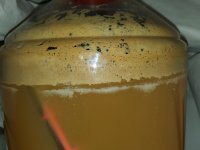Been brewing for years but had a string of infections lately that have me on edge.
I've got a hefeweizen fermenting with WLP300 in a PET carboy with a Tilt hydrometer. It's on day 10 and still churning inside the fermenter and the Tilt is telling me 1.008, 4 points lower than expected FG. Not a great sign.
Underneath the never ending krausen is this ring of sediment. Is this a yeast deposit or is it something else? I've had similar looking deposits in all my infected bottles.
Thanks in advance!
I've got a hefeweizen fermenting with WLP300 in a PET carboy with a Tilt hydrometer. It's on day 10 and still churning inside the fermenter and the Tilt is telling me 1.008, 4 points lower than expected FG. Not a great sign.
Underneath the never ending krausen is this ring of sediment. Is this a yeast deposit or is it something else? I've had similar looking deposits in all my infected bottles.
Thanks in advance!

































![Craft A Brew - Safale BE-256 Yeast - Fermentis - Belgian Ale Dry Yeast - For Belgian & Strong Ales - Ingredients for Home Brewing - Beer Making Supplies - [3 Pack]](https://m.media-amazon.com/images/I/51bcKEwQmWL._SL500_.jpg)

























